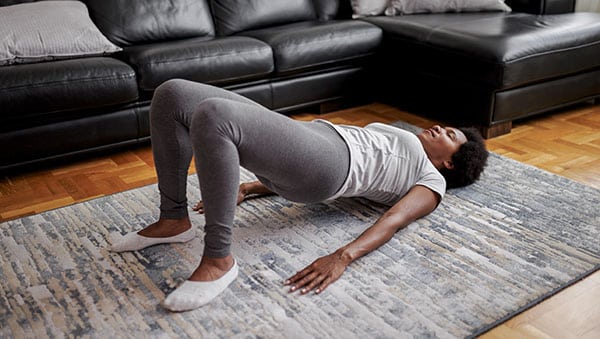Exercises to Strengthen Your Pelvic Floor

You already know about the many benefits of regular exercise, but for people who suffer from pelvic issues, strengthening the pelvic floor muscles is equally important for fitness and health. The pelvic floor muscles are a layer of muscles that support men’s and women’s urinary and reproductive tracts. These muscles also control your bladder and bowels. Both men and women can experience pelvic floor weakness over time.
What type of symptoms might you experience if you have a weak pelvic floor?
- Leaking urine when you cough, sneeze, laugh, or exercise
- Painful intercourse
- Recurrent urinary tract infections
- Difficulty emptying the bowel
- Pelvic or lower back pain
According to the statistics, approximately 32% of women and 16% of men suffer from at least one pelvic floor dysfunction. Below, we’ve detailed four different exercises that can be done to strengthen your pelvic muscles.
Kegels
Kegel exercises focus on tightening and holding the muscles that control urine flow. They are suitable for both men and women.
A Kegel exercise consists of the following steps:
- Sit in a comfortable position, close your eyes, and visualize the muscles that can stop urine flow.
- Tighten these muscles as much as possible.
- Hold this position for 3–5 seconds. It should feel as though the muscles are lifting due to the squeezing.
- Release the muscles and rest for several seconds.
- Do 10-15 reps 3-5 times per day.
- People can vary this exercise by performing it while standing, lying down, or crouching on all fours.
Consistency is key with Kegel exercises. It can take several weeks to see results.
Squeeze and release
This rapid “squeeze and release” exercise builds the pelvic floor muscles’ ability to respond quickly.
To perform this exercise, a person should:
- Sit in a comfortable position.
- Picture the pelvic floor muscles.
- Squeeze the muscles as quickly as possible and release them without attempting to sustain a contraction.
- Rest for 3–5 seconds.
- Repeat the movement 10–20 times.
- Repeat the exercise twice, later in the day.
Bridge
While bridges primarily strengthen the buttocks, they also help work the pelvic floor.
People can do a bridge using these steps:
- Lie down on your back, bend your knees, and place your feet flat on the floor about hip-width apart. Let the arms fall to the sides with the palms facing downward.
- Contract the buttocks and pelvic floor to lift the buttocks several inches off the ground.
- Hold this position for 3–8 seconds.
- Relax the buttocks and pelvic floor muscles to lower the buttocks to the ground.
- Repeat up to 10 times.
- Rest, then perform up to 2 additional sets.
As the strength of the pelvic floor increases, many people will find that they can do more repetitions.
Squats
Squats can promote a stronger pelvic floor and buttocks along with the bridge.
To perform a squat, a person should:
- Stand with your feet hip-width apart, flat on the floor.
- Bend at the knees to bring the buttocks toward the floor, going only as low as is comfortable. Keep the back straight and lean slightly forward. The knees should be in line with the toes.
- Focus on tightening the buttocks and pelvic floor while returning to standing.
- Repeat this exercise to do a total of 10 repetitions.
- Rest before performing any additional sets.
- Not all squats target the pelvic floor. Wide-legged or deep squats may make retaining a pelvic floor contraction difficult. When strengthening the pelvic floor, narrow and shallow squats are more beneficial.
Pelvic Floor Therapist
As urologists, we may recommend that patients work with a pelvic floor therapist. A pelvic floor therapist is a specialized physical therapist who focuses on the pelvic floor muscles and organs. They can assist patients with techniques to strengthen, relax, and coordinate these muscles.
EMSELLA® Chair
Another option for pelvic floor therapy to help improve urinary incontinence and sexual function is an FDA-approved, noninvasive treatment called the EMSELLA Chair. High-intensity focused electromagnetic energy (HIFEM) stimulates pelvic floor muscles. You sit on the chair fully clothed, and it’s like performing thousands of Kegel-like pelvic floor contractions in a single session. EMSELLA Chair treatments are available at MIU’s sexual wellness center, REDEEM.
Prioritize Pelvic Floor Health
Incorporating exercises like Kegels, squeeze and release, bridges, and narrow squats into your workout routine can significantly contribute to a stronger pelvic floor. For those seeking an alternative approach, the non-invasive EMSELLA Chair offers a convenient way to stimulate these vital muscles.
Ultimately, prioritizing the health of your pelvic floor through consistent exercise or advanced therapies can lead to improved overall well-being and a better quality of life.
If you are suffering from bladder leakage or painful sex, schedule an appointment to speak with a urologist at one of our many convenient locations. If you are interested in learning more about the EMSELLA Chair, get in touch with the specialists at MIU’s REDEEM sexual wellness center.

